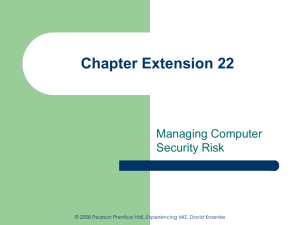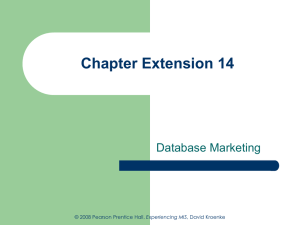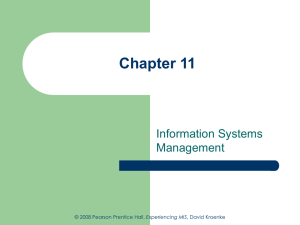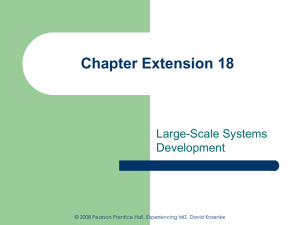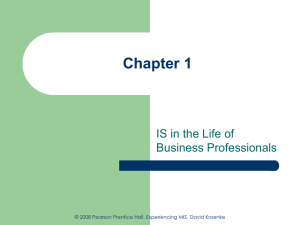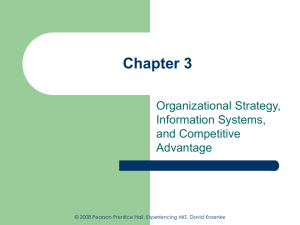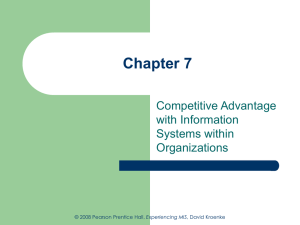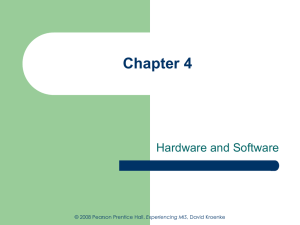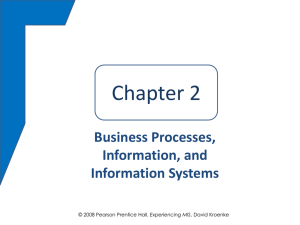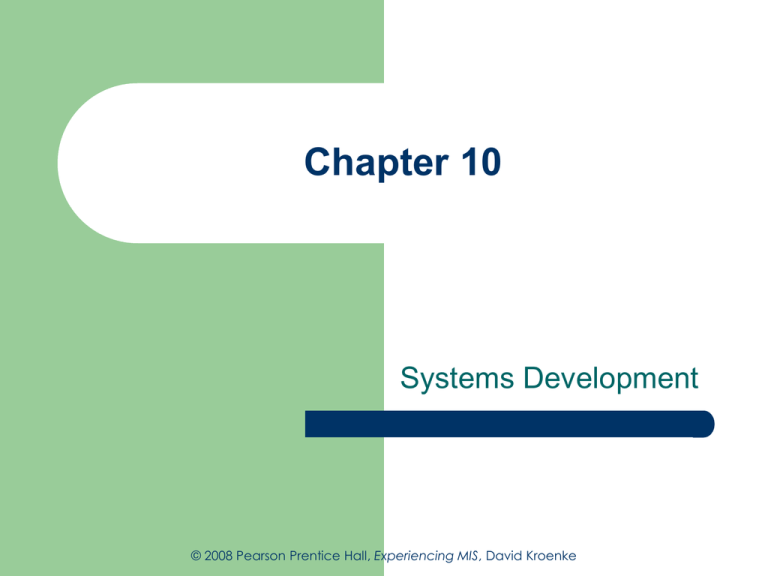
Chapter 10
Systems Development
© 2008 Pearson Prentice Hall, Experiencing MIS, David Kroenke
This Could Happen to You
Dee wanted to develop a blog for communication
–
–
–
Focused goal
Short time frame
Was successful because system was simple
RFID at DSI more sophisticated
–
–
10-2
Single contributor
No user training
Vendors would need to place RFID chips
Computer program would be needed to process data
© 2008 Pearson Prentice Hall, Experiencing MIS, David Kroenke
Study Questions
10-3
What is systems development?
Why is systems development difficult and risky?
What are the five phases of the systems development life
cycle?
How is systems definition accomplished?
What is the user’s role in the requirements phase?
How are the five components designed?
How is an information system implemented?
What are the tasks for systems maintenance?
What are the problems with SDLC?
How does the knowledge from this chapter help DSI?
© 2008 Pearson Prentice Hall, Experiencing MIS, David Kroenke
Systems Development
Systems analysis and design
Process of creating and maintaining information
systems
–
–
Development involves all five components
Requires more than programming or technical expertise
Information systems are never off-the-shelf
–
10-4
Human relation skills
Business knowledge
Understanding of group dynamics
Must be adapted to fit needs of business and people
© 2008 Pearson Prentice Hall, Experiencing MIS, David Kroenke
MIS in Use: Thinking Big about
Systems Development
Large scale corporate information systems are more
complex
–
–
–
10-5
Need to ensure all employees are working toward same
goals
Must develop system that will function consistently in
different languages
May need to store information on worldwide use of product
and the relevant laws
Most information systems are process-design
oriented
Must be carefully planned and executed
© 2008 Pearson Prentice Hall, Experiencing MIS, David Kroenke
Major Development Challenges
Difficulty of determining requirements
Requirements change as system develops
Scheduling and budgeting difficult to estimate
–
Technology changes
Diseconomies of scale
–
10-6
Change as scope changes
Brook’s Law
© 2008 Pearson Prentice Hall, Experiencing MIS, David Kroenke
Systems Development Processes
Methodologies:
–
–
–
–
Systems development life cycle (SDLC)
Rapid application development (RAD)
Object-oriented systems development (OOD)
Extreme programming (XP)
No single process works in all situations
–
–
Different requirements
Some systems wholly automated, others not
10-7
Use augmentation system to fill gaps
© 2008 Pearson Prentice Hall, Experiencing MIS, David Kroenke
SDLC
Classical process with five phases:
–
Systems definition
–
Requirements analysis
–
Implement, test, and install new system
System maintenance
10-8
Based on approved user requirements
Implementation
–
Identify features and functions
Component design
–
Management’s statement defines new system
Repair, add new features, maintain
© 2008 Pearson Prentice Hall, Experiencing MIS, David Kroenke
Phases in SDLC
Figure 10-2
10-9
© 2008 Pearson Prentice Hall, Experiencing MIS, David Kroenke
Systems Definition
Define goals and purpose for new system
–
–
–
Determine project’s scope
–
May be delineated by users, processes, or facilities
Assess feasibility of project
–
–
–
–
10-10
Must facilitate organization’s competitive strategy
Supports business processes
Improves decision making
Cost
Schedule
Technical
Organizational feasibility
© 2008 Pearson Prentice Hall, Experiencing MIS, David Kroenke
Systems Definition, continued
If deemed feasible, project team created
from IT personnel and users
–
–
–
–
10-11
Managers
Systems analysts
Programmers and software testers
Users
© 2008 Pearson Prentice Hall, Experiencing MIS, David Kroenke
Ethics Guide: Estimation Ethics
Buy-ins
–
Companies agree to produce products for less
than it knows will be required
–
In-house projects are often started with buy-ins
–
10-12
“Time and materials” contracts
Fixed-cost contracts
Projects started with hopes of more money later
Team members may disagree about costs
Not all costs may have been included in estimate
Also may have buy-in on schedule
© 2008 Pearson Prentice Hall, Experiencing MIS, David Kroenke
Requirements Analysis Phase
Determine and document features and functions
–
–
Interview users
Document requirements
10-13
Examine existing system
Review reports, forms, queries, application features
Security and controls
Approve requirements
Less expensive to change system in this phase
© 2008 Pearson Prentice Hall, Experiencing MIS, David Kroenke
Designing Components
Develop and evaluate alternatives
–
Hardware design determined by project team
Software design depends on source
–
–
–
10-14
Accurate requirements critical
Off-the-shelf
Off-the-shelf with alterations
Custom-developed programs
Data model converted to database design
Procedures designed for BI system
Job descriptions created for users and operations
personnel
© 2008 Pearson Prentice Hall, Experiencing MIS, David Kroenke
Information System Implementation
System must be built
–
–
System testing
–
–
10-15
Components constructed independently
Document and review
Individual components tested
System integrated and tested
Users must be converted to new system
© 2008 Pearson Prentice Hall, Experiencing MIS, David Kroenke
Systems Testing
Test plan
–
–
–
Product quality assurance (PQA)
–
Testing specialists
Beta testing
–
10-16
Sequences of actions that users take when employing
system
Both normal and incorrect actions should be considered
Labor intensive
Future system users try out system on their own
© 2008 Pearson Prentice Hall, Experiencing MIS, David Kroenke
System Conversion
Converting business activity from old system to new
–
Pilot
–
Phased
10-17
Organization implements entire system on single, limited unit
If systems fails, it only affects limited boundary
Reduces exposure
New system installed in phases
Tested after each phase
Continues until installed at entire organization
Can’t be used in tightly integrated systems
© 2008 Pearson Prentice Hall, Experiencing MIS, David Kroenke
System Conversion, continued
–
Parallel
–
Plunge
10-18
New system runs in parallel with old system during
testing
Expensive and time consuming
Data must be entered twice
Provides easy fallback position
Direct installation
Install new system and discontinue old
There is no backup position
© 2008 Pearson Prentice Hall, Experiencing MIS, David Kroenke
Systems Maintenance
Fixing or adapting system
–
–
–
Need method to track system failures and
enhancements
Corrections usually prioritized based on severity
Enhancements usually prioritized based on
business decision
10-19
Must generate reasonable rate of return
Decision to restart systems development process
© 2008 Pearson Prentice Hall, Experiencing MIS, David Kroenke
Problems With SDLC
SDLC waterfall
–
–
Difficulty in documenting requirements
–
Analysis paralysis or uncertain requirements
Scheduling and budget difficulties
–
–
10-20
Phases are not supposed to be repeated
Often teams have need to repeat requirements and/or
design phases
Multiyear projects difficult to properly schedule
Estimations on labor often produce insufficient budgets
© 2008 Pearson Prentice Hall, Experiencing MIS, David Kroenke
Guide: The Real Estimation Process
Estimating is just theory
Project managers sum up estimates and take
to management
Management then negotiates the schedule
and budget
–
10-21
Every change will negatively impact the project
Start with optimistic schedules and end up
with late projects
© 2008 Pearson Prentice Hall, Experiencing MIS, David Kroenke
How Does the Knowledge from
This Chapter Help You at DSI?
You can now give a summary of the phases
of SDLC
–
–
10-22
Describe tasks more specifically
Create a realistic schedule
© 2008 Pearson Prentice Hall, Experiencing MIS, David Kroenke
Active Review
10-23
What is systems development?
Why is systems development difficult and risky?
What are the five phases of the systems development life
cycle?
How is systems definition accomplished?
What is the user’s role in the requirements phase?
How are the five components designed?
How is an information system implemented?
What are the tasks for systems maintenance?
What are the problems with SDLC?
How does the knowledge from this chapter help DSI?
© 2008 Pearson Prentice Hall, Experiencing MIS, David Kroenke

